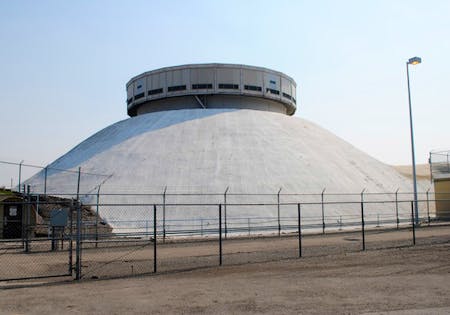
MCRE could be built inside the ZPPR cell (shown here) at INL’s Materials and Fuels Complex. (Photo: INL)
A tiny 200-kWt reactor the Department of Energy says would be the first critical fast-spectrum circulating fuel reactor and the first fast-spectrum molten salt reactor (MSR) could be built and operated inside the Zero Power Physics Reactor (ZPPR) cell at Idaho National Laboratory’s Materials and Fuels Center (MFC). Details included in the Molten Chloride Reactor Experiment (MCRE) draft environmental assessment (EA)—released on March 16 for two weeks of public comment (later extended to four weeks, through April 14)—covered the potential environmental impacts associated with the development, construction, operation, and decommissioning of MCRE at INL, facilitated by the National Reactor Innovation Center (NRIC).
As a liquid-fueled, fast-spectrum, chloride salt–fueled experimental reactor, MCRE (pronounced “McCree”) is a project of Southern Company and TerraPower, funded in part by a Risk Reduction award announced in December 2020 under the DOE’s Advanced Reactor Demonstration Program (ARDP). Southern and TerraPower have partnered with Core Power, Orano Federal Services, and 3M for “technical cost share support” for MCRE. While MCRE will not require a license from the Nuclear Regulatory Commission, the project is intended to increase the knowledge of key phenomena that would be necessary for NRC licensing of TerraPower’s grid-scale Molten Chloride Fast Reactor (MCFR). Southern announced an agreement with the DOE to build MCRE at INL in collaboration with TerraPower and others in November 2021.
What’s involved? MCRE would be assembled and operated inside NRIC’s Laboratory for Operation and Testing in the United States (LOTUS) testbed in the ZPPR cell that, according to the draft EA, could be configured to support the demonstration of “various advanced nuclear energy systems (i.e., reactors) that operate at less than 500 kilowatts.” If the MCRE project goes ahead, after modular components are manufactured off-site they could be assembled on-site in about six months, followed by commissioning and operational phases of about 12 months, according to the draft EA.
The DOE’s involvement would include supporting design and fabrication of the reactor, installing the reactor in the LOTUS testbed, developing and synthesizing fuel salt, and operating and decommissioning the MCRE reactor.
According to the draft EA, “The experimental reactor will not have power conversion equipment and will not rely on traditional solid fissile material for fuel. The intention of the project is to demonstrate the operation of molten fuel salts at temperatures sufficient to drive traditional subcritical and super-critical Rankine cycles, CO2 power cycles, or other less conventional power cycles.”
Fueling MCRE: MCRE would be fueled by “a eutectic mixture of sodium chloride (NaCl) and uranium trichloride (UCl3). The fuel salt will be made from highly enriched uranium (HEU) feedstock synthesized from processing of existing ZPPR fuel plates currently in storage at ZPPR.”
Processing those fuel plates and generating the full amount of fuel salt required for the project—about 2.6 metric tons—is expected to take about two years. As part of the proposed action described in the draft EA, the fuel salt would be synthesized in a Fuel Salt Synthesis Line established at the MFC.
The fuel salt has a calculated melting temperature of about 456°C and would have a nominal fuel salt temperature of 597.5°C. The fuel salt mass flow rate would be 25–100 kg/s, in a reactor with a design pressure of 750 kPa.
What’s the MCFR? A description included in the draft EA and attributed to TerraPower described the MCFR as “an advanced nuclear reactor technology intentionally designed to combine the best aspects of homogeneous (liquid-fueled) reactors, fast reactors, and molten salt reactors (MSR) to create superior performance, safety, and economic benefit when compared to conventional light-water reactors and other advanced reactor concepts. The molten chloride salt fuel of the MCFR serves as both the fuel and the coolant,”
The draft EA also states, “The most significant passive safety features of molten fuel systems are the strong and inherent temperature feedback mechanisms. The fuel density is temperature dependent, and as such, it expands upon increased temperature. The expansion is strong enough to bring the systems subcritical through negative reactivity feedback as fuel temperature increases.”
TerraPower has improved on historic MSR research and development to “eliminate runaway reactions and meltdown scenarios, reduce refueling requirements and reactor size, and operate a reliable source of electricity.”
Still open for comments: The extended four-week public comment period ends on April 14. Comments can be submitted by mail to Willettia Amos, U.S. Department of Energy–Idaho Operations Office, 1955 Fremont Ave., MS 1235, 83415-1222 or by email to [email protected].